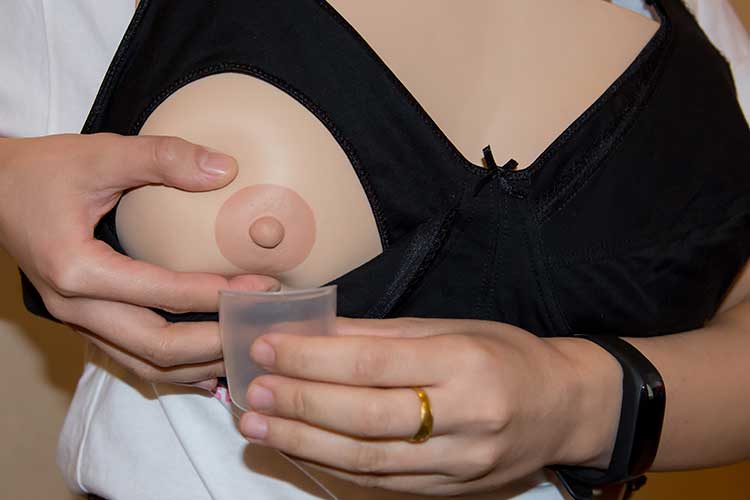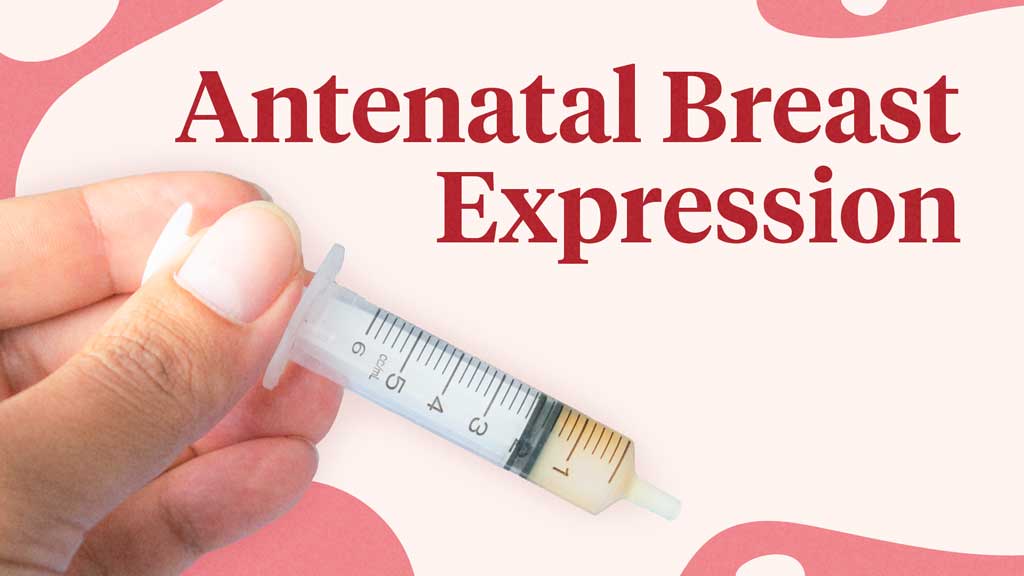Antenatal expression involves collecting colostrum, the first breast milk produced during pregnancy (Australian Breastfeeding Association 2022).
Why Express Colostrum Antenatally?

From about the 16th week of pregnancy, the breasts begin to make colostrum. From around 36 weeks gestation, it’s possible to collect and freeze small amounts, which can then be given to the baby soon after birth (Australian Breastfeeding Association 2022). This can be especially valuable for babies who:
- Have a birthing parent with diabetes, which can cause low blood sugar in the infant
- Have a cleft lip or palate
- Are diagnosed as being small for their gestational age
- Have a congenital condition such as Down syndrome or a heart condition
- Have a birthing parent with breast abnormalities, or who has had breast surgery
- Have a birthing parent who is taking beta-blockers to control high blood pressure
- Are twins or triplets etc.
(ABM 2019)
Early availability of colostrum can also help parents avoid the need to bottle-feed with formula immediately after birth (Australian Breastfeeding Association 2022).
An additional and often overlooked benefit of antenatal expression is that it provides a new parent with the opportunity to practice expressing before their baby is born. This can be especially valuable if parent and baby need to be separated at birth, for example, in the case of premature delivery (Pregnancy, Birth and Baby 2023).
Contraindications and Complications
One concern about antenatal breast expression is the risk of triggering premature labour in those with risk factors, as the hormone oxytocin can be released when expressing, causing the uterus to contract (Pregnancy, Birth and Baby 2023; The Royal Women’s Hospital 2023).
For these reasons, patients may be advised not to express colostrum if:
- A cervical suture is in place
- There is a history of previous premature labour
- There is a history of antepartum haemorrhage or placenta praevia
(Pregnancy, Birth and Baby 2023)
Diabetes: A Special Case for Colostrum Collection
Infants born to parents with diabetes during pregnancy are at increased risk of hypoglycaemia. If the infant’s blood glucose is low in the immediate postnatal period and the parent cannot provide enough breast milk, then formula milk may need to be given. Antenatal breast expression can help to avoid this.
To explore this further, a large randomised controlled trial, the Diabetes and Antenatal Milk Expressing (DAME) study, was conducted between 2011 and 2015 (Forster et al. 2017).
During the DAME study, pregnant patients were taught how to hand express colostrum and encouraged to express twice daily for up to 10 minutes, from 36 weeks gestation until delivery. They were also instructed to stop if there was any sign of uterine activity, vaginal blood loss, decreased fetal movement or hypoglycaemia (Forster et al. 2017).
The study found that for those having their first baby, the increased availability of colostrum meant that their babies were more likely to be exclusively breastfed during their first 24 hours of life. Furthermore, it also showed that patients with diabetes and a low-risk pregnancy can safely express breast milk in late pregnancy without causing harm to their babies (Forster et al. 2017).
Performing Antenatal Breast Expression

It’s recommended that patients express by hand rather than using an electric or manual breast pump, as colostrum is produced in such small quantities it can easily stick to the pump parts, wasting valuable drops of milk (ABM 2019).
To ensure expression is as easy as possible, the patient should be relaxed in a warm, comfortable environment (Cambridge University Hospitals 2021).
The process for performing hand expression is as follows:
- Wash hands thoroughly with soap and water, then dry them well. It can help to apply a warm compress or express after a warm bath or shower to encourage milk flow. Get into a comfortable position, seated and slightly leaning forward.
- Form a ‘C’ shape with the thumb and forefingers, placing the thumb above the nipple and fingers below, about 2 to 3 cm from the base of the nipple where the milk ducts are. Gently press fingers towards the chest without pinching the nipple.
- Compress the breast tissue, hold briefly, and then release. Repeat this process in a rhythmic manner until colostrum starts to appear. The patient may need to adjust their finger position or slightly rotate around the areola to express colostrum from different parts of the breast.
- Use a clean container or sterile syringe to collect the colostrum. Switch to the other breast after two to three minutes or when the flow of colostrum slows down. Express each breast twice per session.
- The colostrum should be carefully stored in a suitable container such as an empty syringe, labelled with the time and date and then frozen until needed.
(Pregnancy, Birth and Baby 2023; ABM 2019; Cambridge University Hospitals 2021)
Conclusion
To date, much of the research available on antenatal expression has focused on the safety of this technique from the birthing parent’s point of view. Yet Casey et al. (2019) point out that there is still no independent association between expressing colostrum antenatally and rates of neonatal hypoglycaemia or median blood glucose levels. That said, antenatal expression may have more general benefits for the newborn, such as reduced formula consumption in the hospital.
Test Your Knowledge
Question 1 of 3
When does the production of colostrum typically begin during pregnancy?
Topics
References
- Association of Breastfeeding Mothers 2019,Expressing Your Milk Before Your Baby Arrives (Antenatal Expressing) , ABM, viewed 10 September 2024, https://abm.me.uk/wp-content/uploads/ABM-antenatal-expressing.pdf
- Australian Breastfeeding Association 2022, Expressing Colostrum Before Baby is Born, Australian Breastfeeding Association, viewed 9 September 2024, https://www.breastfeeding.asn.au/bfinfo/antenatal-expression-colostrum
- Cambridge University Hospitals 2021, Antenatal Hand Expression, National Health Service, viewed 10 September 2024, https://www.cuh.nhs.uk/patient-information/antenatal-hand-expression-of-breast-milk-guidance/
- Casey, J, Banks, J, Braniff, K, Buettner, P & Heal, C 2019, ‘The Effects of Expressing Antenatal Colostrum in Women With Diabetes in Pregnancy: A Retrospective Cohort Study’, Australian and New Zealand Journal of Obstetrics and Gynaecology, vol. 59, no. 6, viewed 10 September 2024, https://obgyn.onlinelibrary.wiley.com/doi/abs/10.1111/ajo.12966
- Forster, DA et al. 2017, ‘Advising Women With Diabetes in Pregnancy to Express Breastmilk in Late Pregnancy (Diabetes and Antenatal Milk Expressing [DAME]): A Multicentre, Unblinded, Randomised Controlled Trial’, The Lancet, vol. 389, no. 10085, viewed 10 September 2024, https://www.thelancet.com/journals/lancet/article/PIIS0140-6736(17)31373-9/fulltext
- Pregnancy, Birth and Baby 2023, Antenatal Expression of Colostrum, Healthdirect Australia, viewed 10 September 2024, https://www.pregnancybirthbaby.org.au/antenatal-expression-of-colostrum
- The Royal Women’s Hospital 2023, Antenatal Expressing: Expressing Breastmilk During Pregnancy, The Royal Women’s Hospital, viewed 10 September 2024, https://thewomens.r.worldssl.net/images/uploads/fact-sheets/Antenatal-expressing-expressing-breastmilk-during-pregnancy%C2%AD230503.pdf
 New
New 
